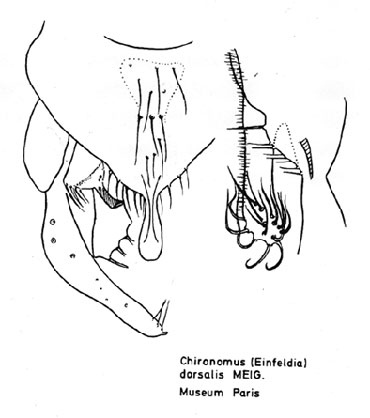Chironomus (Lobochironomus) dorsalis (Meigen 1818)
Described from Japan as C. longipes Staeger, which is currently considered to be a synonym of C. dorsalis. Epler (2001) did not accept the synonymy of C. dorsalis and C. longipes, considering that C. dorsalis was Einfeldia, but C. longipes was Lobochironomus. However Spies and Sæther (2004) confirmed this synonymy but it remains to be clarified whether all specimens do belong to a single species and whether either C. dorsalis or C. longipes occur in Asia.
Doubtful synonym: Einfeldia ocellata Hashimoto 1985. (see under C. ocellatus)
Chironomus longipes sensu Shilova 1980 - needs to be renamed (Vallenduuk & Langton, 2010)
The name Chironomus dorsalis was misapplied to a Chironomus (s.s.) species by Edwards (1929). After re-examination of the type specimen (see below), C. dorsalis Meigen was placed in Einfeldia, but later recognized as a member of the new subgenus Lobochironomus of Chironomus by Ryser, Wälker and Scholl (1985).
The status of the name 'dorsalis' is most confused as it has been used in at least six different ways and it is not always clear in the literature to which species it is applied. It has included the amazing suggestion that the name C. dorsalis should be restricted to C. dorsalis sensu Edwards because there was no valid name for that species, and that the Meigen species should be called by the junior synonym C. longipes!
In BOLD Bin: BOLD:AAW4008
Also in BOLD Bin: BOLD:AAW3454 as C. longipes.
However this appears to be a misidentification, as specimens in this Bin are a form of Benthalia (see Benthalia sp. 3)

Male terminalia, drawn from the type specimen in the Paris Museum. (drawing courtesy of W.F. Wülker).
Adult (based on North American specimens as described by Townes (1945) as Tendipes (Einfeldia) dorsalis):
Male: Wing length 3.2 mm; LR 1.7; AR 3.0, frontal tubercles minute, fore tarsus without beard.
Pale green, with thoracic markings, etc., ochraceous; apical segments of tarsi brown;
abdominal tergites each with a central brown mark over most of the length of the segment, apical tergites entirely brown.
About 9 setae in a single pale area on TIX. Anal point narrow at base and expanded at distal end. Superior volsella a D-type (by definition) of Strenzke (1959) with the apico-median projection strongly extended; Inferior volsella with simple setae, reaching about to the end of the anal point and the mid-point of the moderately swollen gonostylus, which narrows significantly over the posterior third, abt 5+1 setae at tip.
Female: Similar to male except for the usual sexual differences. Only description found is that of Rodova (1978) although it is not clear which form she is describing (She mentions Einfeldia but does not identify to which species this refers).
Length 6-7 mm, wing about 5 mm.
Antennal ratios (units) 17 (neck 0.3) : 11 : 11 : 9 : 18; AR about 0.38; A5/A1 about 1.06.
.jpg)
From Rodova 1978.
Tergite X long and narrow like a crescent moon. Cercus appears to have a curved ventral margin with a basal bulge, posterior margin curved.
Pupa: (from Langton & Visser (2003): Length 5.0-5.4 mm.
Cephalic tubercles 75x55 µm, frontal setae 43 µm.
Basal ring of thoracic horn 78-97 x 33-40 µm. Thoracic granulation well-developed anteriorly and along suture, evanescent elsewhere.
Abdomen: Hook row of segment 2 complete, 50-66 hooks in row 0.45-0.48 of the width of the segment. Abdomen colorless with sooty markings. The point patches are strong points, increasing in size posteriorly, and increase in extent from tergite II to V, but are reduced on VI. Spur of Segment VIII with 1 stout tooth and occasionally a small accessory tooth. Anal lobe with a fringe of 43-50 taeniae.
Fourth instar larva a medium (female about 7.2 mm) melanotus-type (with small lateral projections to about 160 µm) and well developed ventral tubules, anterior pair shorter (ant. 1.2 mm; post 1.36 mm). Gula and frontoclypeus not darkened.
Anal tubules about 250 µm, 3 times longer than wide. Salivary reservoir (1 specimen) abt 70x15 µm, abt 4.7 times wider than deep.
Mentum (Fig. c) with 4th lateral slightly reduced (type I-II), c1 relatively narrow and tall, with c2 teeth relatively well separated (type III).
Ventromental plates (Fig. d) about 3.6-3.7 times wider than deep; separated by about 37-47% of mentum width; with about 42-47 closely spaced striae; VMR about 0.35.
Pecten epipharyngis (Fig a) with about 20-21 teeth (14 normal teeth, the others thinner teeth interspersed between the normal teeth). Premandible teeth sharp (type IIB), inner tooth about 3-4 times wider than the outer tooth.
Antenna (Fig. b) with basal segment 3.25-3.85 times longer than wide; A2 quite long compared to A1 (A1/A2 only about 2.8); AR about 1.18-1.35; ratio of segments (micron) 90 : 32 : 8 : 13: 6.
Mandible (Fig. e) with third inner tooth partly separated and slightly darkened (type IIB), and with 12-15 grooves on outer surface at base.
Cytology: (based on North American material) 4 polytene chromosomes with the thummi-cytocomplex combination AB, CD, EF, G. Arm G with a subterminal nucleolus, a large BR just proximal to it and another BR near other end of chromosome. Other nucleoli on arms B and D.
dlsA1:
dlsB1: Nucleolus (could be the BR found in other Lobochironomus species) near middle of the arm, typical bands 24-28 slightly removed
from the centromere (region "X" of Ryser et al. (1985) reversed?).
dlsC1: Large puff about one third from distal end.
dlsD1: Nucleolus near the centromere.
dlsE1: possibly 1 - 3c, 9 - 10a, 8i-a, 3ed, 10b, 5 - 7, 4 - 3f, 10c - 13
dlsF1: Bands 8-9 about one third from centromere.
dlsG1: subterminal nucleolus with close BR and further distal BR.
Found: Holarctic. Type locality - Europe (France?)(In Paris Museum); Denmark - (Type locality of C. longipes).
India - (BOLD)(needs to be confirmed)
Japan (as C. longipes) but really Benthalia sp. 3 - Wakaguri (36.444°N, 140.083°E), Tsukuba, Kanto (NIES) (see above). .
[ Return to Index | Go to References ]
|

.jpg)